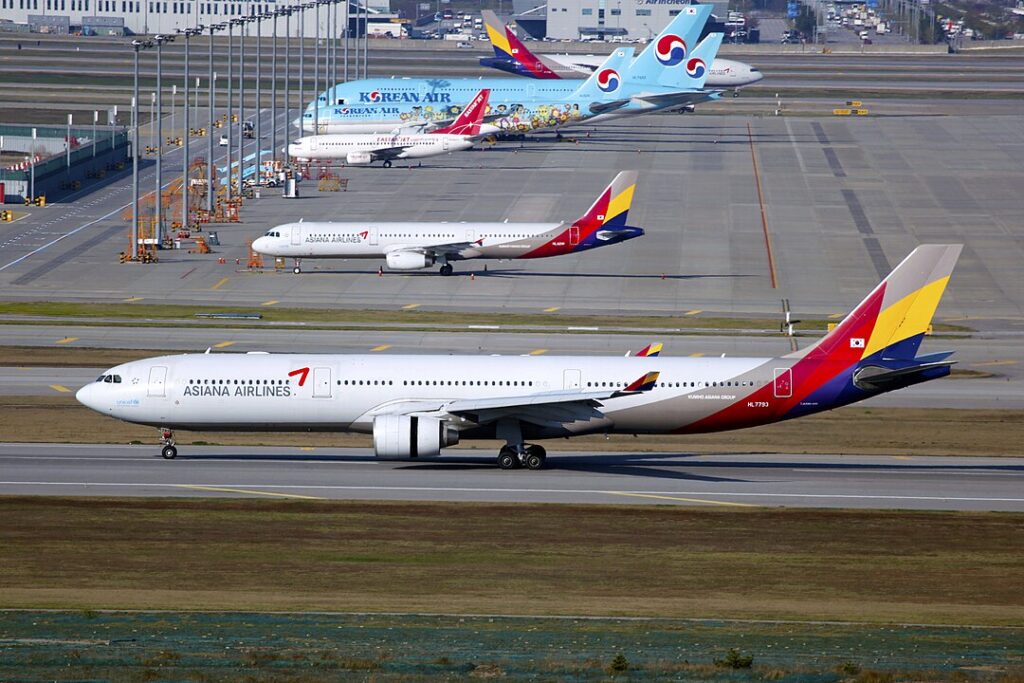
SEOUL - Korean Air (KE) завершает 1,8 триллиона вон ()$1,4 млрд.Слияние с Asiana Airlines (OZ) знаменует собой значительную трансформацию в авиационном ландшафте Южной Кореи, начиная с четверга.
В среду корейский Воздух обеспеченный 63,9 процента Авиакомпания Asiana Airlines завершила четырехлетний процесс слияния. Авиакомпании будут работать независимо в течение следующих двух лет, при этом Asiana будет функционировать как дочерняя компания Korean Air.
 Фото: Byeangel из Цинтао, Китай - HL7793 | Asiana Airlines | Airbus A330-323 | ICN, CC BY-SA 2.0, https://commons.wikimedia.org/w/index.php?curid=40388039
Фото: Byeangel из Цинтао, Китай - HL7793 | Asiana Airlines | Airbus A330-323 | ICN, CC BY-SA 2.0, https://commons.wikimedia.org/w/index.php?curid=40388039Слияние Korean Air и Asiana Airlines
Слияние происходит в период политической неопределенности после спора президента Юн Сук Ёла. Объявление военного положения. Несмотря на первоначальные сбои в поездках, отраслевые аналитики сохраняют оптимизм по поводу быстрой стабилизации рынка.
корейский Воздух сталкивается со значительными проблемами, особенно с чрезмерным соотношением долга к капиталу Азиаты. 2000 процентов. Стратегический финансовый менеджмент будет иметь решающее значение для успешной интеграции.
В течение следующих двух лет, Korean Air (KE) и Азия (OZ) будут функционировать как отдельные организации, при этом Азиатская вспомогательный. Этот тщательно спланированный переход позволяет:
- Постепенное перемещение сотрудников
- Финансовая стабилизация Азиаты
- Систематическая интеграция операций
Объединенный перевозчик стремится стать мировым Седьмая по величине авиакомпания по объему пассажирских перевозок, имея флот приблизительно 250 самолетов Расширенная глобальная связь.
Чтобы получить одобрение ЕС, корейский В воздухе реализованы умные стратегические маневры. Авиакомпания назвала T’way Air «средством правовой защиты» для четырех важнейших европейских маршрутов: Барселона, Франкфурт, Париж и Рим. В обмен на это Korean Air будет оказывать всестороннюю оперативную поддержку, включая авиацию, летные экипажи и сервисное обслуживание.
ЕК также одобрила приобретение Air Incheon грузового бизнеса Asiana, гарантируя, что сектор грузовых авиаперевозок остается конкурентоспособным. Эти расчетные шаги демонстрируют приверженность Korean Air поддержанию рыночной справедливости и агрессивному росту.
 Фото: Hyeonwoo Noh - http://www.airliners.net/photo/Asiana-Airlines/Airbus-A380-841/2505314/L/, CC BY-SA 4.0, https://commons.wikimedia.org/w/index.php?curid=44772783
Фото: Hyeonwoo Noh - http://www.airliners.net/photo/Asiana-Airlines/Airbus-A380-841/2505314/L/, CC BY-SA 4.0, https://commons.wikimedia.org/w/index.php?curid=44772783Оперативная устойчивость
корейский Представители ВВС сохраняют уверенность, подчеркивая:
- Минимальное влияние колебаний валютных курсов
- Флотный состав 9:1 Самолеты, принадлежащие
- Стабильный спрос на пассажиров, несмотря на отмену бронирования
Аналитики прогнозируют потенциальную оптимизацию сети и реструктуризацию маршрутов, поскольку обе авиакомпании постепенно интегрируют свои операции.
Слияние позиционирует объединенную компанию как более сильного конкурента на Азиатско-Тихоокеанском авиационном рынке, потенциально улучшая предложения маршрутов и конкурентоспособные цены.
Впереди вызовы
Основные направления деятельности включают:
- Управление долгом
- Оперативная интеграция
- Поддержание финансовой стабильности
- Навигация по текущей политической и экономической неопределенности
Перспективы экспертов
«Слияние дает значительные долгосрочные выгоды. Однако тщательное финансовое планирование будет иметь решающее значение для обеспечения прибыльности и устойчивости нового предприятия, - сказал анонимный аналитик инвестиционного банка в Сеуле.
Оставайтесь с нами. Следуйте за нами в социальных сетях для последних обновлений.
Присоединяйтесь к нам в Telegram Group для последних обновлений авиации. Следуйте за нами в Google News
Korean Air и Asiana Merger получили одобрение ЕС и ждут «зеленого света» от США
Korean Air завершила слияние с Asiana Airlines стоимостью 1,4 миллиарда долларов, впервые появившись на Aviation A2Z.









